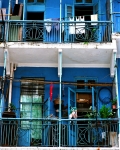Blue House
Archaeology »
Archaeological Monuments » Blue House
Blue House -
Blue House is located in Wan Chai.
Blue House monument was established on 1870.
Primary threats to Blue House :
It is one of the few remaining examples of Tong Lau of the balcony type in Hong Kong. It is classified as Grade I historic building.
Historical facts of Blue House :
The Blue House, known as the "Lan Oi House" in Cantonese, is a historic residence located in Hong Kong. It holds great historical and cultural significance, representing the unique architectural heritage of the city. Let's explore some historical facts about the Blue House:
- Construction and Architectural Style:
The Blue House was constructed in the late 19th century, around 1870, during the colonial era of Hong Kong. It is a four-story building characterized by a distinctive blue-colored facade, which gives the house its name. The architectural style of the Blue House is a combination of Chinese and Western influences, reflecting the fusion of cultures in Hong Kong.
- Original Function:
Originally, the Blue House served as a tenement building, providing housing for working-class residents in the Wan Chai neighborhood. It was part of a larger complex known as the "Sun Yat-sen Medical Center," which housed the first hospital in Hong Kong's history.
- Historical Significance:
The Blue House is historically significant for several reasons. Firstly, it represents the architectural and cultural heritage of Hong Kong, showcasing the blending of Chinese and Western architectural elements. Secondly, it serves as a reminder of the social and economic conditions of the working-class population during the colonial period.
- Preservation Efforts:
In the 1990s, the Blue House faced the threat of demolition due to urban development plans. However, local residents and heritage conservation activists campaigned for its preservation. Eventually, the Hong Kong government recognized its historical value and implemented preservation measures to safeguard the building.
- Decline and Restoration:
Over the years, the Blue House fell into disrepair and faced numerous challenges. By the early 2000s, it was in a dilapidated state, requiring extensive restoration. In 2007, a restoration project was initiated to revive the Blue House and transform it into a cultural and heritage center.
- Blue House Complex:
The Blue House is part of a larger complex that includes three other historic buildings: the Yellow House, the Orange House, and the Purple House. Together, these buildings form a unique architectural ensemble, showcasing the traditional tong lau style prevalent in early 20th-century Hong Kong.
- Present-Day Usage:
Following its restoration, the Blue House now serves as a cultural and heritage center. It houses a museum that showcases the history and heritage of the Wan Chai neighborhood, as well as the stories of its former residents. The building also hosts various community activities, exhibitions, and workshops, promoting cultural exchange and community engagement.
- UNESCO Recognition:
In 2017, the Blue House Complex, along with several other historical sites in Hong Kong, was inscribed on the UNESCO World Heritage List as part of the "Historic Buildings of the Central and Western Districts." This recognition highlights the international significance of the Blue House and its contribution to global cultural heritage.
- Community Engagement:
The Blue House serves as a community hub, actively engaging local residents and promoting cultural initiatives. It offers programs and activities that encourage public participation, such as heritage tours, educational workshops, and cultural events. The Blue House has become a platform for fostering community cohesion and preserving the intangible heritage of Hong Kong.
- Symbol of Identity:
The Blue House stands as a symbol of Hong Kong's cultural identity and heritage. It represents the city's historical roots, the resilience of its communities, and the importance of preserving its architectural treasures. The Blue House is an iconic landmark that showcases the harmonious coexistence of Chinese and Western influences in Hong Kong's history.
- In conclusion, the Blue House is a historically significant building in Hong Kong, representing the fusion of Chinese and Western architectural styles. Through preservation efforts and its transformation into a cultural and heritage center, the Blue House serves as a testament to Hong Kong's architectural heritage, community engagement, and the preservation of its cultural identity.

